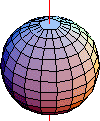
Back حركة دورانية Arabic অক্ষ Bengali/Bangla خولانەوە بە دەوری تەوەرەیەکی جێگیر CKB Çаврăмлă куçăм CV Rotationsmekanik Danish Movimiento rotativo Spanish Biraketa-ardatz Basque چرخش به دور محور ثابت Persian Mouvement de rotation French स्थिराक्ष के परितः घूर्णन Hindi

| Part of a series on |
| Classical mechanics |
|---|
Rotation around a fixed axis or axial rotation is a special case of rotational motion around an axis of rotation fixed, stationary, or static in three-dimensional space. This type of motion excludes the possibility of the instantaneous axis of rotation changing its orientation and cannot describe such phenomena as wobbling or precession. According to Euler's rotation theorem, simultaneous rotation along a number of stationary axes at the same time is impossible; if two rotations are forced at the same time, a new axis of rotation will result.
This concept assumes that the rotation is also stable, such that no torque is required to keep it going. The kinematics and dynamics of rotation around a fixed axis of a rigid body are mathematically much simpler than those for free rotation of a rigid body; they are entirely analogous to those of linear motion along a single fixed direction, which is not true for free rotation of a rigid body. The expressions for the kinetic energy of the object, and for the forces on the parts of the object, are also simpler for rotation around a fixed axis, than for general rotational motion. For these reasons, rotation around a fixed axis is typically taught in introductory physics courses after students have mastered linear motion; the full generality of rotational motion is not usually taught in introductory physics classes.
